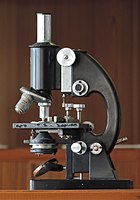
Photo from wikipedia
Owing to the escalating threat of criminal activities and pollution aroused by 2,4,6-trinitrotoluene (TNT) and 2,4,6-trinitrophenol (TNP), development of a proficient sensor for the detection of these explosives is highly… Click to show full abstract
Owing to the escalating threat of criminal activities and pollution aroused by 2,4,6-trinitrotoluene (TNT) and 2,4,6-trinitrophenol (TNP), development of a proficient sensor for the detection of these explosives is highly demanded. Herein, a water-soluble ionic liquid-tagged fluorescent probe, 1-ethyl-3-(3-formyl-4-hydroxybenzyl)-1H-benzimidazol-3-ium chloride (EB-IL) has been designed and synthesized for the detection of TNT and TNP in 100% aqueous medium. The EB-IL fluorescent probe displayed strong cyan-blue fluorescence at 500 nm which gets quenched upon the addition of TNT/TNP over other concomitant nitro-compounds. The distinct binding response of EB-IL towards TNT could be due to the formation of hydrogen bonding between the acidic proton of benzimidazolium (C2-H) and nitro group of TNT. Meanwhile, the selective binding of TNP with EB-IL could be due to the exchange of counter Cl- anion of EB-IL with picrate anion. The fluorescence quenching of EB-IL by TNT could be attributed to the resonance energy transfer (RET) and that of TNP is ascribed to the anion-exchange process. The developed sensor is extremely selective and sensitive towards TNT and TNP with high quenching constants of 1.94 × 105 M-1 and 2.32 × 106 M-1 and shows a lower detection limit of 159 nM and 282 nM, respectively.
Journal Title: Chemosphere
Year Published: 2021
Link to full text (if available)
Share on Social Media: Sign Up to like & get
recommendations!